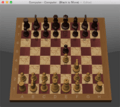Chess and computers facts for kids
Chess and computers have been connected since the earliest days of the computer. In the 19th century Charles Babbage had thought of the idea,p87 and in modern times Alan Turing, the mathematician and Bletchley Park codebreaker, put some thought into the idea. He was not a very good chess player, but was one of the creators of the first British computer. He is also credited with the creation of Computer science.
There are two types of chess programs. One plays against a human opponent; the other helps the user become a better player. The two types can be made to work together, though they have different functions and work in different ways.
Contents
Chess engines
Chess engines are computer systems that can play chess games against human opponents. Many have been created; they can play at master level, though their processes are quite different from those of a human being.p87 The best engines on the fastest computers have won matches against both Kasparov and Kramnik, but the software can be used at an easier level for a learner.
Competitions are run by putting engines against each other, and the results are published. There is a World Computer Chess Championship, in which the details of the rules may determine which software wins. Software may also be rated on other scales, such as ease of usage.
Fritz
Fritz is a German chess program by Frans Morsch and Mathias Feist, published by ChessBase. It is the current market leader. There is also a different kind of Fritz called Deep Fritz that is made for multi-processing. The latest kinds of the consumer products are Deep Fritz 12 and Fritz 12. They came with reviews by Josh Waitzkin, who said that "Fritz is like a woman that you can't get with. It just drives (makes) you to think in ways you've never thought before".
Shredder
Shredder is a leading engine. It is also owned by ChessBase. It comes in various forms: Shredder 12, Deep Shredder 12; Shredder Classic. It has a reputation of being hard.
Rybka
Rybka, a product by Vasik Rajlich, is Shredder's main rival. Rybka 4 is their latest version.
Chess databases
Chess databases do not actually play. They give access to the recorded history of master chess. There are two components. First, there is the software, which lets one search and organise the database material. Then there is the actual database, typically one to four million games.
In practice, databases are used for two purposes. First, for a player to train his/her ability at specific openings. Second, to look up specific opponents to see what they play, and prepare against them beforehand.
The existence of chess databases is one way that young players can achieve mastery at an early age.
ChessBase
ChessBase is the biggest database, and widely used by masters. Although it can be used online, most users download the software and data onto their laptop. Then they take the laptop to tournaments, to help prepare for games. Players may not use computers or any other aid during games, but much preparation goes on behind the scenes. ChessBase has to be purchased, and it is not cheap.
New in Chess
This is a Dutch magazine for advanced players, which runs an on-line database called NicBase as part of its services. NicBase is free, and has over a million games.
Chessgames
Chessgames.com runs an on-line database of games. It is partly free, but requires registration. Full access to all its facilities is by a fairly modest subscription. It has over half a million games on its database.
On-line playing sites
There are websites which a player can join (for a fee) and play on line. In this case, the subscriber will play against other subscribers, not a computer. All standards of players are amongst the members, and various events are on offer at different rates of play. The two leaders in this market are:
- Internet Chess Club
- Playchess
Images for kids
-
Screenshot of Chess, a component of macOS
-
DGT Centaur (2019), a modern chess computer based on Stockfish running on a Raspberry Pi









